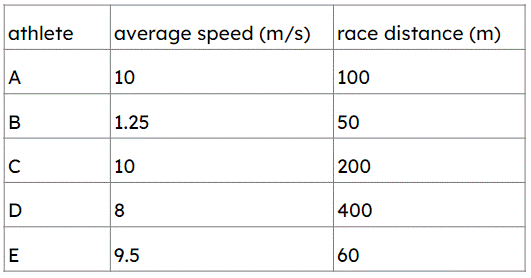Myths about teaching can hold you back
These resources will be removed by end of Summer Term 2025.
Switch to our new teaching resources now - designed by teachers and leading subject experts, and tested in classrooms.
These resources were created for remote use during the pandemic and are not designed for classroom teaching.
Lesson details
Key learning points
- The greater the speed of an object, the shorter the time it takes to cover a certain distance.
- The greater the speed of an object, the more distance it travels in a certain time.
- Speed = distance ÷ time.
- Speed is measured in m/s or km/h or miles/h.
- m/s is the number of metres travelled each second.
Keywords
Distance - a length between two points, usually measured in metres (m)
Time - a duration, usually measured in seconds (s)
Speed - the distance it travels each second
Metres per second (m/s) - the standard unit used to measure speed
Miles per hour (mph) - the unit often used to measure vehicles’ speeds
Common misconception
"Constant speed" can be interpreted as "moving all the time", and "steady speed" as "not too fast".
Use the terms with care, qualifying them with examples when they are used, e.g. "a constant speed of 4 m/s" or "a steady speed of 100 m/s".
To help you plan your year 8 science lesson on: Calculating speed, download all teaching resources for free and adapt to suit your pupils' needs...
To help you plan your year 8 science lesson on: Calculating speed, download all teaching resources for free and adapt to suit your pupils' needs.
The starter quiz will activate and check your pupils' prior knowledge, with versions available both with and without answers in PDF format.
We use learning cycles to break down learning into key concepts or ideas linked to the learning outcome. Each learning cycle features explanations with checks for understanding and practice tasks with feedback. All of this is found in our slide decks, ready for you to download and edit. The practice tasks are also available as printable worksheets and some lessons have additional materials with extra material you might need for teaching the lesson.
The assessment exit quiz will test your pupils' understanding of the key learning points.
Our video is a tool for planning, showing how other teachers might teach the lesson, offering helpful tips, modelled explanations and inspiration for your own delivery in the classroom. Plus, you can set it as homework or revision for pupils and keep their learning on track by sharing an online pupil version of this lesson.
Explore more key stage 3 science lessons from the Moving by force unit, dive into the full secondary science curriculum, or learn more about lesson planning.

Equipment
Licence
Prior knowledge starter quiz
6 Questions
Q1.Which of these are units of distance?
Q2.Which word is used to describe how fast or slow an object is moving?
Q3.Starting with the shortest, put the values in order of length.
Q4.Which two pieces of information could you use to work out the speed of a motorcycle after it has finished a journey?
Q5.Match the description of movement to the distance travelled in a certain time.
2 metres each hour
1 metre each second
9 metres each second
60 miles each hour
900 kilometres each hour
Q6.A red car and a blue car start at the same time and travel the same distance along a track. The red car takes 20 s to reach the end and the blue car takes 25 s. Which of the statements are correct?
Assessment exit quiz
6 Questions
Q1.Two cars travel along a track for the same amount of time. The green car travels twice as far as the red car. Which of these statements is true?

Q2.Which of these equations involving speed, distance and time is correct?
Q3.A cyclist travels at an average speed of 15 m/s for 45 seconds. Calculate the distance they travel.

Q4.A speedboat travels 70 miles in 3.5 hours. Calculate the speed of the boat.
Q5.The table shows the speeds of athletes in races of different lengths. Starting with the longest time, put the athletes into order of how long it took them to finish their race.



